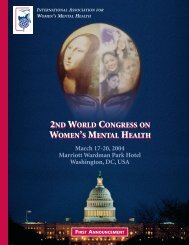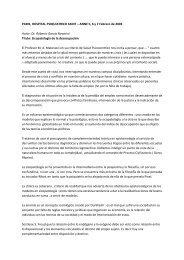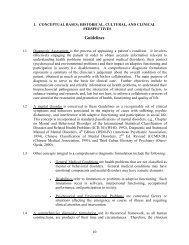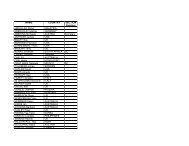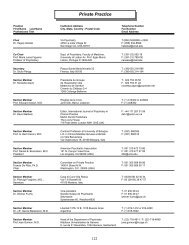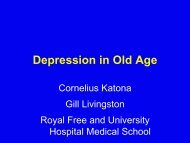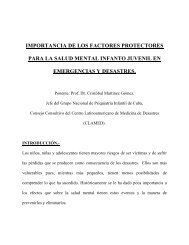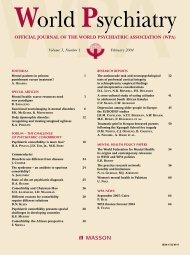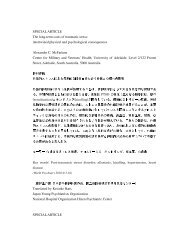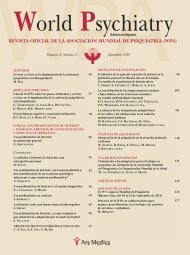ABSTRACTS - World Psychiatric Association
ABSTRACTS - World Psychiatric Association
ABSTRACTS - World Psychiatric Association
Create successful ePaper yourself
Turn your PDF publications into a flip-book with our unique Google optimized e-Paper software.
the drug self-administration model the animal self administers the<br />
drug (intravenously or orally). Thus, these two animal models can be<br />
complementary and represent, so far, the most reliable tools to investigate<br />
neurobiology and possible therapies in drug addiction.<br />
RS33.2.<br />
NEW TARGETS FOR TREATING DRUG<br />
DEPENDENCE: THE ROLE OF THE AMYGDALA<br />
M. Cador<br />
Université Victor Segalen, Bordeaux, France<br />
Opiate withdrawal leads to the emergence of an aversive state that can<br />
be conditioned to a specific environment. Reactivation of these withdrawal<br />
memories has been suggested to be involved in relapse to drugseeking<br />
of abstinent opiate addicts. Among the limbic areas that are<br />
likely to mediate these features of opiate dependence, amygdala nuclei<br />
represent critical neural substrates. Using a conditioned place aversion<br />
paradigm (CPA), we have previously shown specific opposite patterns<br />
of reactivity in the basolateral (BLA) and the central (CeA) amygdala,<br />
when comparing the experience of acute opiate withdrawal with the<br />
re-exposure to a withdrawal-paired environment. These data gave<br />
clues about the potential mechanisms by which amygdala nuclei may<br />
be involved in withdrawal memories. To extend these results, the present<br />
study aimed to assess the cellular reactivity and plasticity of amygdala<br />
nuclei during the opiate withdrawal conditioning process. For<br />
this, we have quantified c-fos and arc expression using in situ<br />
hybridization in rats, following each of the three conditioning sessions<br />
during CPA, and after re-exposure to the withdrawal-paired environment.<br />
BLA output neurons showed an increase in the expression of the<br />
plasticity-related arc gene during conditioning that was also increased<br />
by re-exposure to the withdrawal-paired environment. Interestingly,<br />
the CeA showed an opposite pattern of responding, and the intercalated<br />
cell masses (ITC), a possible inhibitory interface between the BLA<br />
and CeA, showed a persistent activation of c-fos and arc mRNA. We<br />
report here specific c-fos and arc patterns of reactivity in amygdala<br />
nuclei during withdrawal conditioning. These findings improve our<br />
understanding of the involvement of the amygdala network in the formation<br />
and retrieval of withdrawal memories. Plasticity processes<br />
within BLA output neurons during conditioning may participate in<br />
increasing the BLA reactivity to conditioned stimuli, which could in<br />
turn (by the control of downstream nuclei) reinforce and drive the<br />
motivational properties of withdrawal over drug consumption.<br />
RS33.3.<br />
CLINICAL GOALS FOR DRUG ADDICTION THERAPY<br />
W. van den Brink<br />
University of Amsterdam, The Netherlands<br />
Both clinical experience and neurobiological evidence indicate that<br />
opioid dependence is a chronic relapsing disorder. Treatment objectives<br />
depend on the pursued goals: crisis intervention, abstinence-oriented<br />
treatment (detoxification and relapse prevention), or agonist<br />
maintenance treatment. The high quality of solid evidence in the literature<br />
demonstrates that there are numerous effective interventions<br />
available for the treatment of opioid dependence. Crisis intervention,<br />
frequently necessary owing to the high overdose rate, can be effectively<br />
handled with naloxone. Abstinence-oriented interventions are<br />
effective for only a few motivated patients with stable living conditions<br />
and adequate social support. Agonist maintenance treatment is<br />
considered the first line of treatment for opioid dependence. Numerous<br />
studies have shown efficacy for methadone and buprenorphine<br />
treatment, while maintenance with other agonists is also becoming<br />
available to a greater extent. Maintenance treatment with diamorphine<br />
should be made available for the small group of treatmentresistant,<br />
severely dependent addicts. Other harm-reduction measures<br />
can serve to engage individuals with opioid addiction who are<br />
not in treatment. In conclusion, opioid dependence is a chronic<br />
relapsing disease that is difficult to cure, but effective treatments are<br />
available to stabilize patients and reduce harm, thereby increasing life<br />
expectancy and quality of life.<br />
RS33.4.<br />
OPIOID DEPENDENCE AND PREGNANCY<br />
G. Fischer<br />
Department of Psychiatry and Psychotherapy, Medical University<br />
of Vienna, Austria<br />
The management of opioid dependence during pregnancy has<br />
received considerable attention over the past three decades. Recent<br />
peer-reviewed literature in the fields of pregnancy and opioid dependence<br />
and neonatal abstinence syndrome has been evaluated and discussed.<br />
Pregnant opioid-dependent women must be carefully managed<br />
to minimize harm to the fetus; therefore, standardized care for<br />
maternal health is required. In a multidisciplinary care system, opioid<br />
maintenance therapy is the recommended treatment approach during<br />
pregnancy. Equivalent attention must be given to the treatment of<br />
neonatal abstinence syndrome, which occurs in 55-94% of neonates<br />
after intrauterine opioid exposure with a 60% likelihood of requiring<br />
treatment. Heterogeneous rating scales as well as heterogeneous<br />
treatment approaches are often responsible for extended hospital<br />
stays. The interpretation of available literature is confounded by several<br />
methodological flaws. In general, there is still a lack of evidencebased<br />
study designs for pharmacological treatment of these patients<br />
as well as for the neonatal abstinence syndrome.<br />
RS33.5.<br />
PHARMACOLOGICAL VS. PSYCHOSOCIAL<br />
INTERVENTIONS IN THE THERAPY OF ADDICTION<br />
M. Davoli<br />
Department of Epidemiology, Local Health Unit E, Rome, Italy<br />
Several pharmacological approaches aimed at opioid detoxification<br />
are effective. Nevertheless, a majority of patients relapse to heroin use,<br />
and relapses are a substantial problem in the rehabilitation of heroin<br />
users. Some studies have suggested that the sorts of symptoms which<br />
are most distressing to addicts during detoxification are psychological<br />
rather than physiological. We explored the benefit from adding psychosocial<br />
interventions to detoxification treatments by searching the<br />
Cochrane Drugs and Alcohol Group trials register, the Cochrane Central<br />
Register of Controlled Trials (CENTRAL), PUBMED, EMBASE,<br />
CINAHL, PsycINFO and a reference list of articles. Nine studies<br />
involving people were included. These studies considered five different<br />
psychosocial interventions and two substitution detoxification<br />
treatments: methadone and buprenorphine. The results show promising<br />
benefit from adding any psychosocial treatment to any substitution<br />
detoxification treatment in terms of completion of treatment (RR<br />
1.68; 95% CI 1.11 to 2.55); use of opiate (RR 0.82; 95% CI 0.71 to<br />
0.93), results at follow-up (RR 2.43; 95% CI 1.61 to 3.66), and compliance<br />
(RR 0.48; 95% CI 0.38 to 0.59). Thus, psychosocial treatments<br />
offered in addition to pharmacological detoxification treatments are<br />
effective in terms of completion of treatment, use of opiate, results at<br />
follow-up and compliance. Limitations to this review are imposed by<br />
the heterogeneity of the assessment of outcomes. Because of lack of<br />
detailed information, no meta-analysis could be performed.<br />
65



